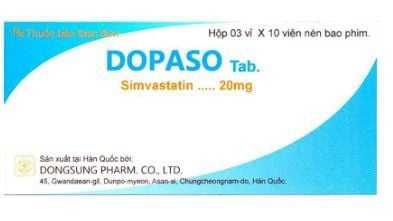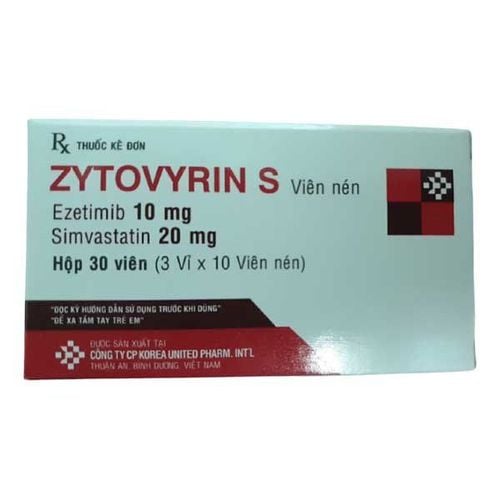This is an automatically translated article.
Stavid drug with the main ingredient is Simvastatin. Stavid is used as an adjunct to diet in patients with primary hypercholesterolemia who have not responded to diet and/or have used other measures alone. In addition, Stavid also helps reduce LDL cholesterol in patients with both hypercholesterolemia and hypertriglyceridemia.1. What effects does Stavid have?
Stavid has the main active ingredient is Simvastatin, the drug is prepared in the form of film-coated tablets with a strength of 20mg.Simvastatin is a lipid-lowering drug, Simvastatin is synthesized from the enzyme product of Aspergillus terreus. This is an inhibitor of the 3-hydroxy-3-methylglutaryl-coEnzyme A (HMG-CoA) reductase, which catalyzes the conversion of HMG-CoA to mevalonate.
Conversion of HMG-CoA to mevalonate is the first step in cholesterol biosynthesis. Simvastatin, after being absorbed from the gastrointestinal tract, is hydrolyzed to a 3-hydroxy acid form that effectively inhibits the reductase enzyme HMG-CoA. Through the above process will inhibit cholesterol synthesis. Inhibition of HMG-CoA reductase occurs first in the liver. Simvastatin inhibits the enzyme HMG-CoA reductase, reduces cholesterol synthesis in the liver and reduces cholesterol levels in cells. This stimulates an increase in the LDL-cholesterol receptor on the hepatocyte membranes, thereby increasing the clearance of LDL-cholesterol from the circulation. Simvastatin is effective in reducing plasma levels of total cholesterol, LDL- cholesterol and VLDL- cholesterol. Simvastatin also reduces triglyceride levels. Simvastatin reduced triglycerides, total cholesterol, and low density cholesterol by 10%, 25% and 35%, respectively. In addition, Simvastatin increased plasma HDL-cholesterol by up to 12%.
2. Indications and contraindications for taking Stavid
2.1. Point
Stavid is indicated as adjunct to diet in patients with primary hypercholesterolemia (hyperlipoproteinaemia IIa and IIb, due to elevated low-density lipoprotein cholesterol (LDL) in patients at risk for coronary heart disease. ) who have not responded to diet and/or have used other measures alone. Reducing LDL cholesterol in patients with both hypercholesterolemia and hypertriglyceridemia.2.2. Contraindications
Allergy or hypersensitivity to Simvastatin, an HMG-CoA reductase inhibitor or any of the ingredients in Stavid. Existing active liver disease or unexplained persistent elevations of transaminases. Women who are pregnant or breastfeeding.3. How to take Stavid
3.1. Dosage
It is recommended that treatment be started with the lowest effective dose of Stavid, then, if necessary, the dose of Stavid can be adjusted according to individual patient needs and response. To adjust the dose by increasing the dose at intervals of not less than 4 weeks, it is necessary to monitor the adverse effects of Stavid, especially the reaction to the muscle system.Before treatment with Stavid, patients need to follow a diet to reduce low-molecular cholesterol, and during treatment with Stavid should continue to diet.
Recommended starting dose of Stavid: 10mg/day, taken once in the evening. Maximum dose: 40mg/day.
Monitor cholesterol levels and the dose of Stavid should be reduced if cholesterol levels fall significantly below the therapeutic target.
3.2. Overdose and treatment
A few cases of Stavid overdose have been reported, however, there were no symptoms specific to overdose and the patient recovered on his own without leaving any sequelae. The maximum dose recorded is 450mg. If symptoms of overdose appear, stop using Stavid and take the patient to a medical facility for timely treatment. Symptomatic and supportive treatment is essential, in addition, liver function tests should be performed in case of overdose.4. Undesirable effects when using Stavid
Simvastatin is generally well tolerated. However, there may be some side effects in the gastrointestinal tract such as bloating, abdominal pain, diarrhea, constipation, nausea, heartburn and dysgeusia. Muscular side effects are rare but may be characterized by muscle pain or weakness. Myoglobinuria and acute renal failure have also been reported in a few cases. Increased plasma creatine phosphokinase concentrations were observed in 11% of patients receiving simvastatin. Some other side effects on the central nervous system: Headache, dizziness, blurred vision, insomnia, weakness, cognitive impairment (such as memory loss, confusion) may be encountered but rarely. Eye symptoms such as blurred vision and cataracts are very rare. The elevation of liver enzymes is transient and reversible upon discontinuation of the drug. Hyperglycemia, increased HbA1c. Other possible side effects include rash, itching, impotence.5. Some notes when using Stavid
Serum transaminase testing prior to initiating treatment with Stavid. Then every 6 weeks for the first 3 months of taking the drug, every 8 weeks for a year, and periodically tested at intervals thereafter.Patients who drink a lot of alcohol or have a history of hepatobiliary disease should use caution when using Stavid. Simvastatin should be temporarily or completely discontinued in patients with acute infections, major surgery, trauma, hypotension, endocrine and electrolyte disturbances, and uncontrolled epilepsy.
Simvastatin may increase plasma levels of transaminases and creatine phosphokinase. This should be considered in the differential diagnosis of chest pain in patients being treated with Simvastatin.
Consider creatine kinase monitoring in some cases:
Before starting treatment, a creatine kinase test should be performed in the following cases: renal failure, hypothyroidism, personal or family history of myopathy transmission, personal history of myopathy due to simvastatin or fibrate use, history of liver disease, heavy alcohol consumption, older patients >70 years of age with risk factors for rhabdomyolysis. In these cases, the benefits and risks of using Stavid should be weighed, and the patient should be monitored clinically during treatment. If creatine kinase test results are >5 times the upper limit of normal, treatment with simvastatin should not be initiated. During the use of Stavid, when there are muscle symptoms such as muscle pain, stiffness, and weakness, the patient should notify the doctor and do a creatine kinase test for appropriate intervention. Ability to drive and operate machines: After taking Stavid, if patients have symptoms of headache, dizziness, drowsiness, they should not drive or operate machinery.
Pregnant women: Stavid is not recommended for pregnant women or patients planning to become pregnant.
Lactating women: Stavid should not be used by women who are breastfeeding, as Stavid may cause potentially dangerous side effects to a nursing infant.
6. Drug interactions
Anticoagulants, coumarin derivatives, indandione: Simvastatin concomitant use with these drugs may increase bleeding time or prothrombin time. Regularly monitor prothrombin time in patients on treatment with these drugs using simvastatin. Cholestyramine, Colestipol: Concomitant use with Simvastatin may decrease the bioavailability of simvastatin. Therefore, Stavid should be administered 4 hours after cholestyramine or colestipol. Cyclosporin, gemfibrozil, erythromycin, immunosuppressants: there may be an increased risk of myoglobinuria and acute renal failure when Stavid is used concomitantly with these drugs. Monitor for symptoms of myoglobinuria or myopathy during concomitant treatment with simvastatin and gemfibrozil, an immunosuppressant. Digoxin: Concomitant administration of Simvastatin may slightly increase serum digoxin concentrations. Increased risk of muscle damage when statins are used concurrently with the following drugs: Gemfibrozil, other fibrate-lowering cholesterol, high-dose Niacin (> 1 g/day), Colchicin Contraindicated to use Stavid in combination with inhibitors Strong CYP3A4 such as: Itraconazole, Ketoconazole, Erythromycin, Clarithromycin, Telithromycin, HIV protease inhibitors, Boceprevir, Telaprevir, Posaconazole, Cyclosporin. Do not use more than 10mg Simvastatin/day when combined with the following drugs: Verapamil, Diltiazem, Dronedaron. Contraindications to the combination of the above drugs with drugs containing Simvastatin content > 20mg). Do not use more than 20mg Simvastatin/day when used in combination with: Amiodarone, Amlodipine, Ranolazine. Avoid drinking large amounts of grapefruit juice (>1 liter per day) while using Stavid. Concomitant use of statins with lipid-lowering drugs for HIV and hepatitis C (HCV) may increase the risk of muscle damage, most seriously rhabdomyolysis, kidney failure leading to kidney failure and possibly kidney failure. deadly.Please dial HOTLINE for more information or register for an appointment HERE. Download MyVinmec app to make appointments faster and to manage your bookings easily.













